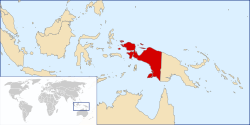United Nations Temporary Executive Authority
| West New Guinea (West Irian) | ||||||||||
| United Nations protectorate | ||||||||||
|
||||||||||
|
||||||||||
|
Location of West New Guinea in Southeast Asia.
|
||||||||||
| Capital | Kotabaru | |||||||||
| Languages |
Dutch Papuan languages Austronesian languages |
|||||||||
| Political structure | Protectorate | |||||||||
| Administrator | ||||||||||
| • | 1962–1963 | Djalal Abdoh | ||||||||
| Historical era | Cold War | |||||||||
| • | Established | 1 October 1962 | ||||||||
| • | Disestablished | 1 May 1963 | ||||||||
| Area | 420,540 km² (162,371 sq mi) | |||||||||
| Currency | Netherlands New Guinean gulden | |||||||||
|
||||||||||
| Today part of |
|
|||||||||
The United Nations Temporary Executive Authority (UNTEA) / United Nations Security Force in West New Guinea (UNSF) was established during October 1962 in accord with General Assembly resolution 1752 as requested in Article two of the New York Agreement to administer the colony of West New Guinea. The UNTEA administration ended on 1 May 1963.
Western New Guinea became the focus of a political dispute between the Netherlands and Indonesia following the recognition of the independence of the latter. The Indonesian side claimed the territory as its own while the Dutch side maintained that its residents were not Indonesian and that the Netherlands would continue to administer the territory until it was capable of self-determination.
In May 1959 an United States diplomat proposed a scheme for using a "a special United Nations trusteeship over the territory for a limited number of years, at the end of which time sovereignty would be turned over to Indonesia"; and in March 1961 the US Embassy in Jakarta asserted "the Indos once contended that UN trusteeship would be anathema under any circumstances. Now, although they have not gone so far as to be willing to call a trusteeship a trusteeship, they talk in terms of “one or two years” of some kind of interregnum as being acceptable."
Indonesia began landing paratroops onto the territory of Western New Guinea in December 1961 which prompted a political crisis between the Netherlands and Indonesia. The United States mediate in the dispute and this led to the signing of the New York Agreement in September 1962.
The agreement offered to transfer the administration from the Netherlands to a United Nations temporary authority on 1 October 1962, and gave the United Nations a discretion to transfer all or part of the administration to Indonesia. The United Nations General Assembly approved the agreement and accepted administration on 21 September 1962 in General Assembly resolution 1752; and on 1 May the following year accept transferred the administration of the territory to Indonesia. The agreement also included assurances by Indonesia of the practices it would exercise if the United Nations chose to transfer the administration to Indonesia, among the assurances was promise that all men and women of West New Guinea who were not foreign nations would be eligible to vote in an Act of Free Choice at a later stage to determine the permanent status of the territory.
...
Wikipedia



